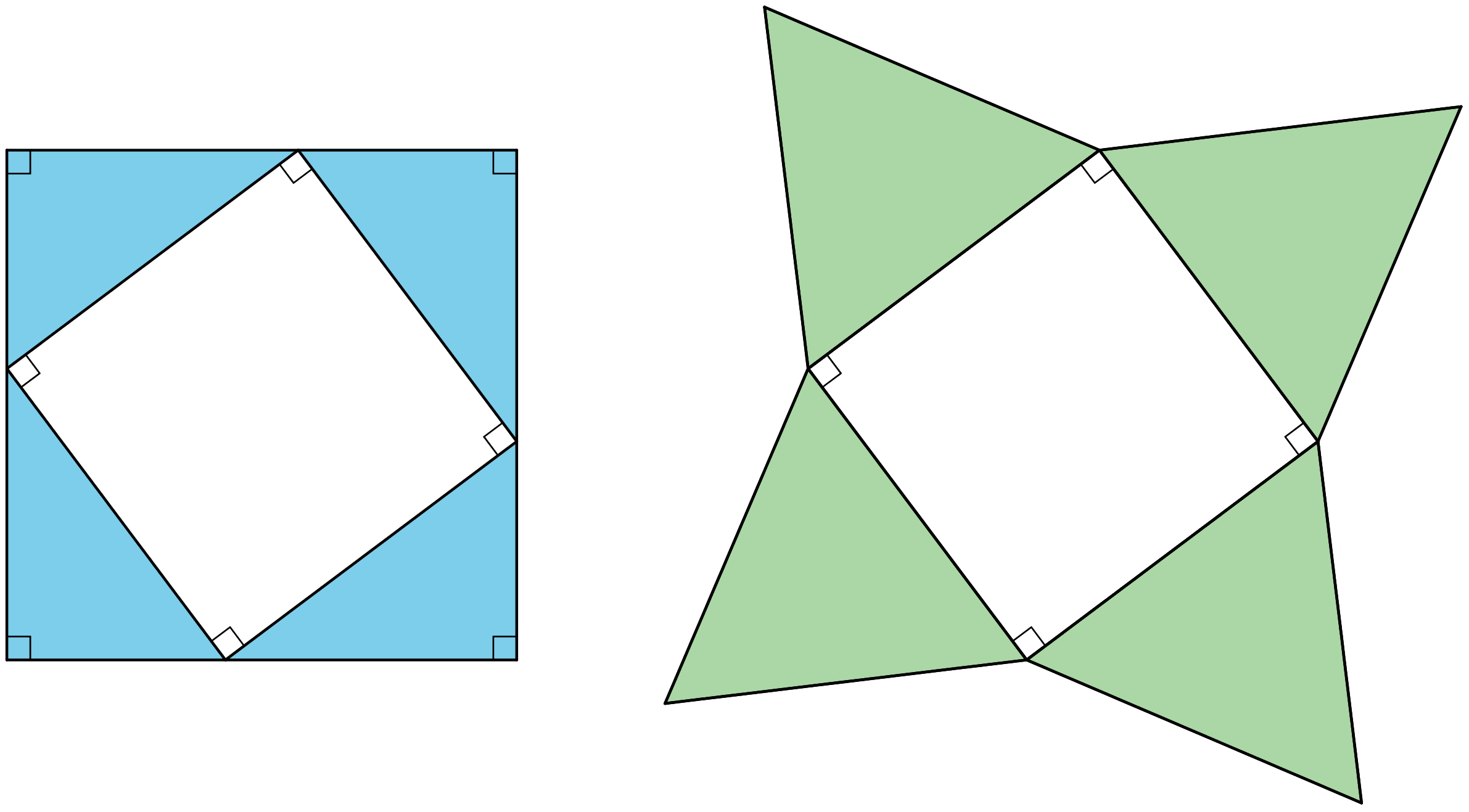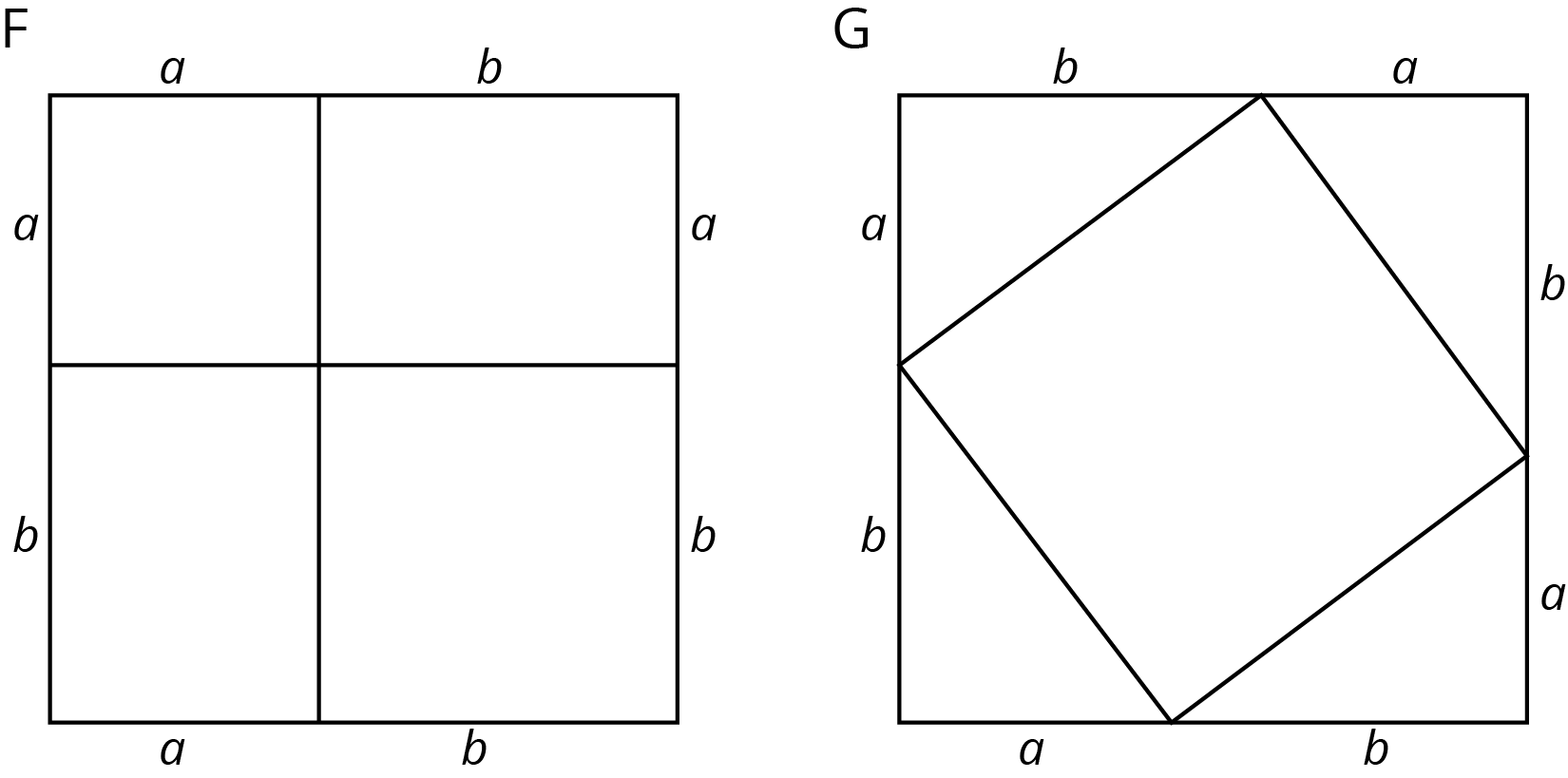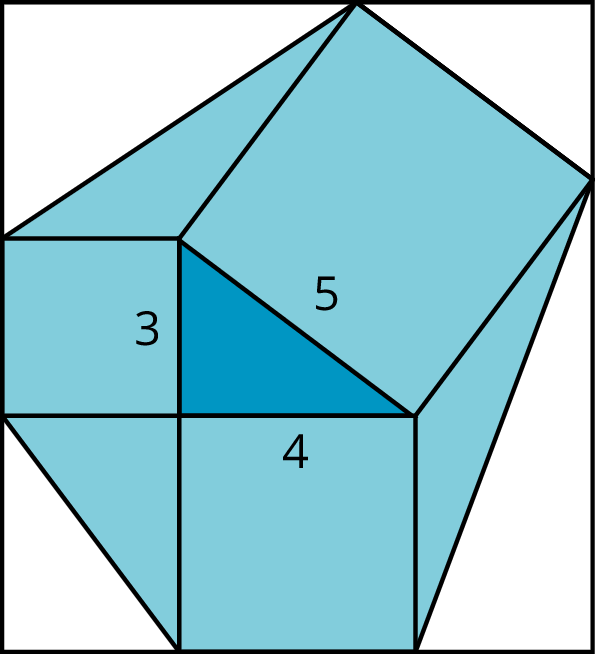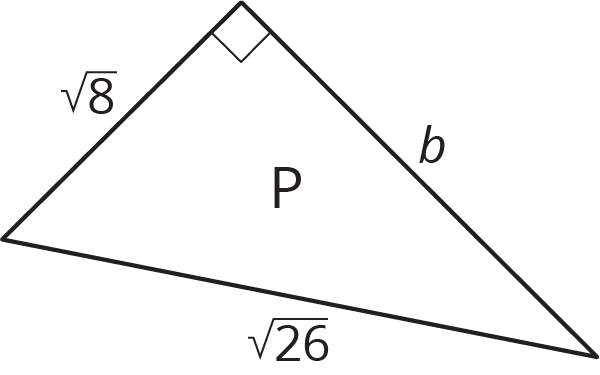Lesson 6
A Proof of the Pythagorean Theorem
6.1: Notice and Wonder: A Square and Four Triangles (5 minutes)
Warm-up
The purpose of this warm-up is to give students a chance to study a diagram that they will need to understand for an upcoming proof of the Pythagorean Theorem. The construction depends on the triangles being right triangles, so students get to contrast it with a similarly constructed figure with non-right triangles. In that case, the composite figure is not a square.
Launch
Arrange students in groups of 2. Display the diagram for all to see. Give students 1 minute of quiet work time to identify at least one thing they notice and at least one thing they wonder about the diagram. Ask students to give a signal when they have noticed or wondered about something. When the minute is up, give students 1 minute to discuss their observations and questions with their partner. Follow with a whole-class discussion.
Student Facing

What do you notice? What do you wonder?
Student Response
For access, consult one of our IM Certified Partners.
Activity Synthesis
Ask students to share the things they noticed and wondered. Record and display their responses for all to see. If possible, record the relevant reasoning on or near the image. After each response, ask the class whether they agree or disagree and to explain alternative ways of thinking, referring back to the images each time.
Tell students that when you take a square and put a congruent right triangle on each side as shown on the left, they form a larger square (they will be able to prove this in high school). But it doesn’t work if the triangles are not right triangles. We will use this construction in the next activity.
6.2: Adding Up Areas (15 minutes)
Activity
The purpose of this activity is for students to work through an area-based algebraic proof of the Pythagorean Theorem (MP1). One of the figures used in this particular proof, G, was first encountered by students at the start of the year during a unit on transformations and again in a recent lesson where they reasoned about finding the area of the triangles.
While there are many proofs of the Pythagorean Theorem similar to the one in this activity, they often rely on \((a+b)^2=a^2+2ab+b^2\), which is material beyond the scope of grade 8. For this proof, students reason about the areas of the two squares with the same dimensions. Each square is divided into smaller regions in different ways and it is by using the equality of the total area of each square that they uncover the Pythagorean Theorem. The extension uses this same division to solve a challenging area composition and decomposition problem.
Launch
Begin by explaining to students how the two figures are constructed. Each figure starts with a square with side length \(a+b\).
- Figure F partitions the square into two squares and two rectangles.
- Figure G takes a right triangle with legs \(a\) and \(b\) and puts one identical copy of it in each corner of the square. The copies touch each other because the short leg of one and the long leg of the one next to it add up to \(a+b\), so they fit exactly into a side. So they form a quadrilateral in the middle. We know the quadrilateral is a square because
- The corners must be 90 degree angles:
- The two acute angles in each triangle must sum to 90 degrees because the sum of the angles in a triangle is 180 degrees, and the third angle is 90 degrees.
- The two smaller angles along with one of the corners of the quadrilateral form a straight angle with a measure of 180 degrees, that means that the angle at the corner must also be 90 degrees.
- All four sides are the same length: they all correspond to a hypotenuse of one of the congruent right triangles.
- The corners must be 90 degree angles:
Arrange students in groups of 2. Give 3 minutes of quiet work time for the first two problems. Ask partners to share their work and come to an agreement on the area of each figure and region before moving on to the last problem. Follow with a whole-class discussion.
Supports accessibility for: Conceptual processing
Design Principle(s): Maximize meta-awareness
Student Facing
Both figures shown here are squares with a side length of \(a + b\). Notice that the first figure is divided into two squares and two rectangles. The second figure is divided into a square and four right triangles with legs of lengths \(a\) and \(b\). Let’s call the hypotenuse of these triangles \(c\).

- What is the total area of each figure?
- Find the area of each of the 9 smaller regions shown the figures and label them.
- Add up the area of the four regions in Figure F and set this expression equal to the sum of the areas of the five regions in Figure G. If you rewrite this equation using as few terms as possible, what do you have?
Student Response
For access, consult one of our IM Certified Partners.
Student Facing
Are you ready for more?
Take a 3-4-5 right triangle, add on the squares of the side lengths, and form a hexagon by connecting vertices of the squares as in the image. What is the area of this hexagon?

Student Response
For access, consult one of our IM Certified Partners.
Activity Synthesis
Begin the discussion by selecting 2–3 groups to share their work and conclusion for the third question. Make sure the last group presenting concludes with \(a^2+b^2=c^2\) or something close enough that the class can get there with a little prompting. For example, if groups are stuck with the equation looking something like \(a^2+ab+b^2+ab=\frac12ab+\frac12ab+\frac12ab+\frac12ab+c^2\), encourage them to try and combine like terms and remove any quantities both sides have in common on each side.
After groups have shared, ask students how they see the regions in each figure matching the regions in the other figure. For example, since the two small squares in Figure F match the one large square in Figure G, how do the rectangles and triangles match? After some quiet think time, select 1–2 students to explain how they see it. (The area of the two rectangles is the same as the area of two of the triangles since, if I put two of the triangles together, I get a rectangle that is \(a\) wide and \(b\) long.) Show students an image with the diagonals added in, such as the one shown here, to help make the connection between the two figures clearer.

Note how these figures can be made for any right triangle with legs \(a\) and \(b\) and hypotenuse \(c\).
6.3: Find the Missing Side Lengths (20 minutes)
Activity
The purpose of this activity is to give students practice finding missing side lengths in a right triangle using the Pythagorean Theorem.
Launch
Arrange students in groups of 2. Give students 10 minutes of quiet work time and then have them compare with a partner. If partners disagree about any of their answers, ask them to explain their reasoning to one another until they reach agreement. Follow with a whole-class discussion.
Supports accessibility for: Memory; Conceptual processing
Student Facing
- Find \(c\).

- Find \(b\).

- A right triangle has sides of length 2.4 cm and 6.5 cm. What is the length of the hypotenuse?
- A right triangle has a side of length \(\frac14\) and a hypotenuse of length \(\frac13\). What is the length of the other side?
-
Find the value of \(x\) in the figure.

Student Response
For access, consult one of our IM Certified Partners.
Student Facing
Are you ready for more?
The spiral in the figure is made by starting with a right triangle with both legs measuring one unit each. Then a second right triangle is built with one leg measuring one unit, and the other leg being the hypotenuse of the first triangle. A third right triangle is built on the second triangle’s hypotenuse, again with the other leg measuring one unit, and so on.

Find the length, \(x\), of the hypotenuse of the last triangle constructed in the figure.
Student Response
For access, consult one of our IM Certified Partners.
Activity Synthesis
Ask students to share how they found the missing side lengths. If students drew triangles for the two questions that did not have an image, display a few of these for all to see, noting any differences between them. For example, students may have drawn triangles with different orientations or labeled different sides as \(a\) and \(b\).
For the last question, ask students to say what they did first to try and solve for \(x\). For example, while many students may have found the length of the unknown altitude first and then used that value to find \(x\), others may have set up the equation \(34-5^2=18-x^2\).
Point out that when you know two sides of a right triangle, you can always find the third by using the Pythagorean identity \(a^2 + b^2 = c^2\). Remind them that it is important to keep track of which side is the hypotenuse.
Design Principles(s): Cultivate conversation; Maximize meta-awareness
6.4: A Transformational Proof (15 minutes)
Optional activity
In this activity, students explore a transformations-based proof of the Pythagorean Theorem, calling back to their work with transformations earlier in the year. Since this proof is not one students are expected to derive on their own, the focus of this activity is on understanding the steps and why they are possible from a transformations perspective.
Listen for students using precise language when describing their transformations.
The digital activity demonstrates the same proof in a slightly different way. Students have the opportunity to explore three different right triangles in the applets.
Launch
Tell students that today we are going to think about how to use transformations to show the relationship between the sides of right triangles. Briefly review the language of rigid transformations (translation, rotation, reflection) with students using the 5 pre-cut pieces from the Making Squares blackline master from the first lesson in this unit.
Arrange students in groups of 2. Before students begin, remind them that if a problem asks them to explain, then they are expected to use precise language when describing the transformation of the shapes. Distribute pre-cut shapes from the Making Squares blackline master and the A Transformational Proof blackline master to each group. Leave 3–4 minutes for a whole-class discussion.
For students using the digital activity, there are no paper copies needed. Have students work in groups of two with the digital applet to explore the relationship between the squares and the Pythagorean Theorem.
Supports accessibility for: Organization; Attention
Design Principle(s): Support sense-making; Maximize meta-awareness
Student Facing
Use the applets to explore the relationship between areas.
-
Consider Squares \(A\) and \(B\).
-
Check the box to show the pieces.
-
Check the box to turn \(C.\)
-
Arrange the five pieces to fit inside Square \(C\).
-
Check the box to see the right triangle.
-
Arrange the figures so the squares are adjacent to the sides of the triangle.
- If the right triangle has legs \(a\) and \(b\) and hypotenuse \(c\), what have you just demonstrated to be true?
- Try it again with different squares. Estimate the areas of the new Squares, \(A\), \(B\), and \(C\) and explain what you observe.
- Estimate the areas of these new Squares, \(A\), \(B\), and \(C\), and then explain what you observe as you complete the activity.
- What do you think we may be able to conclude?
Student Response
For access, consult one of our IM Certified Partners.
Launch
Tell students that today we are going to think about how to use transformations to show the relationship between the sides of right triangles. Briefly review the language of rigid transformations (translation, rotation, reflection) with students using the 5 pre-cut pieces from the Making Squares blackline master from the first lesson in this unit.
Arrange students in groups of 2. Before students begin, remind them that if a problem asks them to explain, then they are expected to use precise language when describing the transformation of the shapes. Distribute pre-cut shapes from the Making Squares blackline master and the A Transformational Proof blackline master to each group. Leave 3–4 minutes for a whole-class discussion.
For students using the digital activity, there are no paper copies needed. Have students work in groups of two with the digital applet to explore the relationship between the squares and the Pythagorean Theorem.
Supports accessibility for: Organization; Attention
Design Principle(s): Support sense-making; Maximize meta-awareness
Student Facing
Your teacher will give your group a sheet with 4 figures and a set of 5 cut out shapes labeled D, E, F, G, and H.
-
Arrange the 5 cut out shapes to fit inside Figure 1. Check to see that the pieces also fit in the two smaller squares in Figure 4.
-
Explain how you can transform the pieces arranged in Figure 1 to make an exact copy of Figure 2.
-
Explain how you can transform the pieces arranged in Figure 2 to make an exact copy of Figure 3.
-
Check to see that Figure 3 is congruent to the large square in Figure 4.
-
If the right triangle in Figure 4 has legs \(a\) and \(b\) and hypotenuse \(c\), what have you just demonstrated to be true?
Student Response
For access, consult one of our IM Certified Partners.
Activity Synthesis
Select previously identified groups to share their explanations for each transformation and their conclusion to the last problem. If possible, have them show each transformation for all students to see.
An important takeaway for this activity is that this proof can be generalized to any right triangle. To help students see why, ask them to consider how the diagonal lines in Figure 1 were created. Give 1–2 minutes for partners to discuss and then select 2–3 groups to share their ideas. Hopefully, at least one group noticed that the diagonals create two congruent right triangles with sides of length \(a\), \(b\), and \(c\)—the same as the original right triangle. This means that this process could be duplicated to show that for any right triangle with legs \(a\) and \(b\) and hypotenuse \(c\), \(a^2+b^2=c^2\) is true.
Lesson Synthesis
Lesson Synthesis
6.5: Cool-down - Could be the Hypotenuse, Could be a Leg (5 minutes)
Cool-Down
For access, consult one of our IM Certified Partners.
Student Lesson Summary
Student Facing
The figures shown here can be used to see why the Pythagorean Theorem is true. Both large squares have the same area, but they are broken up in different ways. (Can you see where the triangles in Square G are located in Square F? What does that mean about the smaller squares in F and H?) When the sum of the four areas in Square F are set equal to the sum of the 5 areas in Square G, the result is \(a^2 + b^2 = c^2\), where \(c\) is the hypotenuse of the triangles in Square G and also the side length of the square in the middle. Give it a try!

There are many examples where the lengths of two legs of a right triangle are known and can be used to find the length of the hypotenuse with the Pythagorean Theorem. The Pythagorean Theorem can also be used if the length of the hypotenuse and one leg is known, and we want to find the length of the other leg. Here is a right triangle, where one leg has a length of 5 units, the hypotenuse has a length of 10 units, and the length of the other leg is represented by \(g\).
Start with \(a^2+b^2=c^2\), make substitutions, and solve for the unknown value. Remember that \(c\) represents the hypotenuse: the side opposite the right angle. For this triangle, the hypotenuse is 10.
\(\begin{align} a^2+b^2&=c^2 \\ 5^2+g^2&=10^2 \\ g^2&=10^2-5^2 \\ g^2&=100-25 \\ g^2&=75 \\ g&=\sqrt{75} \\ \end{align}\)

Use estimation strategies to know that the length of the other leg is between 8 and 9 units, since 75 is between 64 and 81. A calculator with a square root function gives \(\sqrt{75} \approx 8.66\).